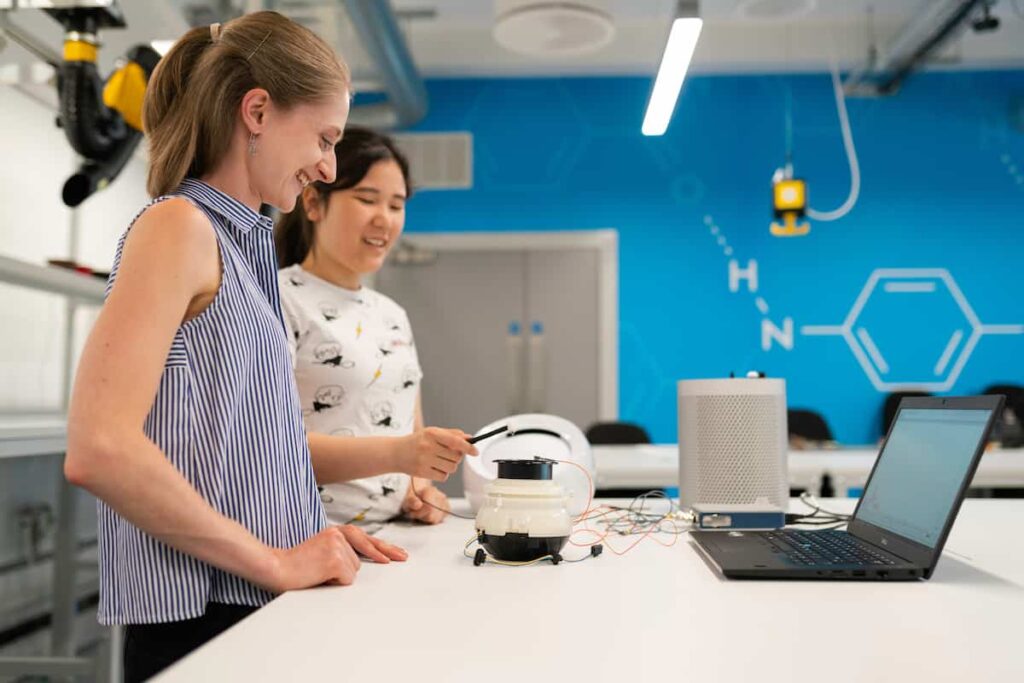In today’s digitally-obsessed era, the education industry has evolved dramatically. With the growing popularity of digital media and audio-visual equipment, schools and institutions have become tech-savvy. Plus educators are making themselves up-to-date with digital tools, to deliver experiential learning experiences to learners.
In order to engage learners, instructors must be creative in their approach and present original ideas that will spark their interest in the material being covered. Technology tools are now essential components of learner-learning systems because technology in education is important in today’s society.
Schools have embraced technology as an essential component of their educational process. This has led them to offer computer science classes at a young age, where young minds are taught to code and use it in their academics to shape their own future.
In today’s classroom, the usage of online technology in education has become more prevalent. This is because it allows kids to study at a much faster rate than they would if they did not have access to these tools and programs. Let’s see the future of education and the role of future technology in education.
What role does technology play in education?

Technology simplifies each aspect of the education industry. Here are the points that explain the importance of educational technology in the real world.
Instant access to an educational material
The variety of educational technology available today provides pupils with numerous possibilities. They can choose the choice that best meets their educational needs from among these options.
As a result, individuals are able to get the necessary skills and information to flourish in their chosen industries. They also receive access to the most recent and relevant information on any issue. For example, referring to a paper published online to write a class assignment will earn you more points and keep you on top of the subject than leafing through a stack of encyclopedias at home.
Enhanced communication and performance
Students who can effectively communicate through technology will outperform their non-technical peers in the workplace and in academia. When trying to convey messages clearly, communication skills are crucial.
More enjoyable and engaging learning experience
Today, learning entails more than just performing the task. It is also necessary to learn how to have fun. Distractions are common among students. Particularly given the time-consuming influence of social media. Students will remain engaged and motivated if they learn using educational technology.
Anytime, anywhere learning
Our lives have gotten so entwined with the internet that it is difficult to find somebody who does not use it on a daily basis. Access to the internet at any time and from any location is critical for today’s students. They require information access to complete their assignments and research at any time without having to travel or wait for a specific time.
Edtech can help them with this. Students can use educational technology to connect to the internet whether they are at home, in a classroom, or at school.
Stay current and relevant
One of the most important aspects of life that everyone should be able to enjoy is the pursuit of new skills and information. Through a number of online programs, technology can assist you in developing these skills and knowledge. They provide people with the opportunity to learn about various areas that are of interest to them and will help them in their vocations or academic domains. People who desire to try out a new job route can also have access to online programs that teach them the necessary skills.
Improve and learn new skills
The use of instructional technology has an effect on a person’s health as well. It has the potential to improve the learner’s mental and physical wellness. Individuals can increase their learning skills and cognitive abilities by using these tools, which is reflected in their academic success and physical well-being.
Keep up to date
Technology improvements enable students to broaden their knowledge of several fields and learn new skills that will be useful in the future. Students who keep up with the newest technology breakthroughs will benefit from expanding their knowledge in a variety of sectors. These students will be well-equipped to obtain a job sooner, in addition to having a solid understanding of modern technology.
What are the different EdTech tools used by teachers in education?
There are a wide range of EdTech tools available for teachers to enhance the learning experience for their students. Here are some of the most commonly used ones:
- Learning Management Systems (LMS): These are online platforms that allow teachers to deliver course content, manage student progress, and communicate with students and parents. LMSs typically include features like content management, grade books, discussion boards, and messaging tools. They also often allow for customization and integration with other educational technology tools.
- Video conferencing tools: Video conferencing tools enable teachers to conduct virtual classes and meetings with students, regardless of their location. They can be used for live lectures, discussions, and group work. Video conferencing tools also offer features like screen sharing, virtual backgrounds, and recording options.
- Interactive whiteboards: Interactive whiteboards are digital whiteboards that allow teachers to create and display interactive lessons, share multimedia content, and collaborate with students in real-time. They often include features like touch screens, handwriting recognition, and digital pens. Interactive whiteboards can be used for a wide range of subjects and can help teachers create engaging and interactive learning experiences.
- Digital assessment tools: Digital assessment tools allow teachers to create and grade quizzes, tests, and assignments digitally. They can be used to assess student learning in real-time, provide immediate feedback, and automate grading. Digital assessment tools also often include analytics and reporting features that can help teachers track student progress and identify areas for improvement.
- Collaborative tools: Collaborative tools enable students to work together on projects and assignments, even if they are not in the same physical location. They can be used for group discussions, brainstorming, and peer editing. Collaborative tools also often include features like chat, video conferencing, and real-time collaboration.
- Augmented and virtual reality tools: Augmented and virtual reality tools offer immersive learning experiences that can help students visualize complex concepts and interact with virtual objects. They can be used for subjects like science, history, and art. Augmented and virtual reality tools also often include features like 360-degree video, simulations, and quizzes.
- Gamification tools: Gamification tools use game mechanics to make learning more engaging and motivating for students. They can be used for subjects like math, language, and social studies. Gamification tools also often include features like leaderboards, badges, and rewards.
EdTech Trends to Watch Out for in 2023
EdTech is rapidly evolving and changing the way that teachers teach and students learn. The below EdTech trends 2023 are just a few examples of the many ways that technology is transforming education.
#1 Personalized learning
With the increasing availability of data and AI-based tools, personalized learning is likely to become even more prominent in the coming years. Personalized learning involves adapting teaching methods and content to the individual needs and preferences of each student, providing them with a more tailored and effective learning experience.
#2 Hybrid and remote learning
The COVID-19 pandemic has accelerated the adoption of hybrid and remote learning models, and these are likely to continue to be used in the future. Schools and universities are increasingly offering online and hybrid courses, and technology tools such as video conferencing, LMSs, and digital assessment tools are being used to support these models.
#3 Augmented reality and virtual reality (AR/VR)
Augmented and virtual reality technologies are becoming more accessible and affordable, and are being used to create immersive and engaging learning experiences. These technologies can help students visualize complex concepts, explore virtual environments, and interact with digital objects.
#4 Gamification and game-based learning
Game-based learning is a fun and engaging way to motivate students and reinforce learning. Gamification tools are being used to incorporate game-like elements, such as points, badges, and leaderboards, into traditional learning environments.
#5 Artificial intelligence and machine learning
AI and machine learning are being used to personalize learning, improve assessments, and support teachers in a range of ways. These technologies can help teachers analyze student data, identify areas where students are struggling, and provide personalized feedback and support.
Conclusion
It’s pretty amazing how far technology has progressed. It is critical to acknowledge that students are growing up in a technologically advanced world and to provide them with a unique opportunity to access and experience these advances. Students should be provided several opportunities to employ available technology in order to stay current and contribute to global progress as effectively as feasible.
Schools are using technology to better how they analyze, present, exchange, and access information. Furthermore, this can aid in the effective delivery of lessons, particularly for children with special needs.
Students can learn a variety of practical skills using technology, such as creating new abilities, learning how to find trustworthy internet sources of information, accessing information and sharing assignments, and so on. Students can learn these abilities in the classroom using technology.
Further Reading:
Enterprise Mobility Solutions: Key Advantages for Businesses




